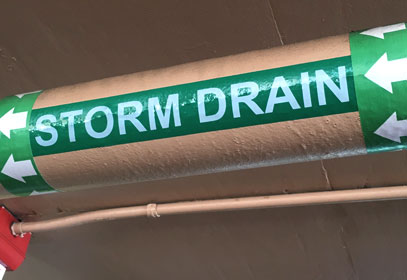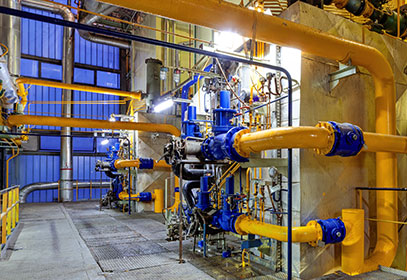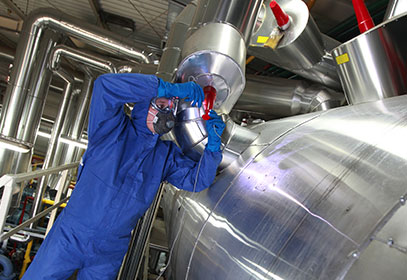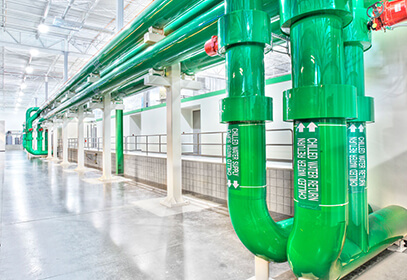Resources
Pipe marking is a must for workplace safety, but its more critical when it comes to labeling pipes carrying ammonia. Ammonia is corrosive to the skin eyes, and lungs, and at the right concentrations, is a flammable and explosive substance.
Although it’s considered to be a serious health hazard with the potential to be fatal, ammonia is still used in a number of industries today. A good portion of the anhydrous ammonia being produced these days are used for fertilizer in the agricultural industry and many commercial food operations still rely on ammonia as a reliable and efficient refrigerant. For wherever ammonia is used, the pipes carrying it must be marked. In this resource center you can find information on:
- IIAR: As the International Institute of Ammonia Refrigeration, IIAR is a leading advocate for establishing ammonia safety guidelines. IIAR published Bulletin #114 creating an industry standard for ammonia pipe labels.
- Pipe Marking Standards: Unlike regular ANSI/ASME pipe labels, ammonia labels have five specific elements conveying more detailed information about the chemical flowing through the pipe.
- HazCom: Having hazardous chemicals in the workplace calls for a hazard communication program. If your company uses ammonia, it is important to stay up-to date on GHS standards and OSHA regulations.
Ammonia exposure can be extremely harmful but investing in the right pipe labels is a cost-efficient and effective preventative measure. If you haven’t reviewed your facility’s pipes in a while, take a walk around your facility and make notes of what labels are missing. Whether you need a handful of ammonia pipe markers or a hundred, we are here to help.
Getting Started
- Don't know where to start? Find out what labels you need with the pipe marking calculator.
- Want to learn more about pipe labels? Explore our pipe marking resources.
- Have a question about ammonia pipe marking? Browse our ammonia pipe labeling Q&A hub.
- Ready to get started? Shop our selection of ammonia pipe marking supplies.
Ammonia Pipe Marking Articles
Your Guide to Pipe Labeling Standards
If you are looking to implement or update a pipe marking strategy for your facility it is important to gathering as much information as possible. Read More... …
A Guide to Pipe Marking Standards
For most industries, abiding by ASME/ANSI pipe marking standards is sufficient for staying safe and OSHA compliant. Some workplaces, though, are required to comply to more unique pipe marking standards due to the nature of the substance the pipes contain. …
Anhydrous Ammonia – Safety & Labeling
Concentrated (or anhydrous) ammonia presents significant hazards to people and the environment. Here’s what you need to know to stay safe. …
Ammonia Refrigeration
When using ammonia refrigeration, or ammonia for anything in the workplace, there are a variety of OSHA regulations that need to be followed. …
Pipe Color Codes - ANSI/ASME A13.1
The ANSI/ASME A13.1 pipe marking color code explained. …
Ammonia Pipe Marking Questions and Answers
Is ammonia basic?
A base is any molecule that accepts a proton, while an acid is any molecule that releases a proton. For this reason, ammonia is considered basic because its nitrogen atom has an electron pair that readily accepts a proton. However, ammonia is classified as a weak base which is a chemical compound that doesn’t completely… …
Is ammonia safe to use?
“Is ammonia safe to use” may sound like a trick question, as you might have seen from our other Q&As on ammonia that it can be dangerous, yet has various uses for fertilizer and refrigeration. There are several pros and cons to using ammonia that make it hard to pin down the exact right answer.… …
What colors should ammonia pipe labels be?
Pipe marking can be difficult, especially when the labels must be correct, since handling hazardous materials is no laughing matter. Ammonia labels fall high on the list due to ammonia’s dangerous nature. There are several different colors that must accompany an ammonia label. These colors correlate with the five different parts of an ammonia label… …
What are ammonia pipe labels and where are they placed?
Any sort of pipe that contains ammonia must be appropriately labeled to assure the awareness of each employee on the contents of the pipe, especially when it contains something as corrosive as ammonia. The regulations on size and color are listed in the ANSI/ASME A 13.1 2015 ruling with the IIAR’s bulletin #114 guidelines to… …
What is the IIAR?
The IIAR is an acronym for the International Institute of Ammonia Refrigeration. The institute oversees the standards on labeling industrial refrigeration equipment for all those who interact with the refrigeration system and its necessary components. The IIAR does this through education and advocacy as they are striving to be the main provider on performance standards… …
How is ammonia used in refrigeration?
To answer this question, we must first look into why ammonia is used in the first place. Back when refrigeration was needing more synthetic refrigerants in the 20th century, chlorofluorocarbons were more commonplace or refrigerants like Freon-12. These synthetic refrigerants were used until it was found that they were dangerous to the environment, that’s when… …
How do ammonia refrigeration systems work?
To start off, refrigeration systems essentially move heat out of one area to another leaving an area cooler than it was before. This process is the basic transfer of energy by moving it from one place to the next with the use of vapor compression. Think of this process as similar to sweating, it keeps… …
How does anhydrous ammonia work?
This manufactured chemical is made through the Haber-Bosch process that fixes hydrogen and nitrogen together by using a highly pressurized and heated catalyst plus an industrial reactor to make the chemical compound known as NH3. Keeping this manufactured chemical in a stable condition where it can be handled is imperative as it is very volatile… …
What is anhydrous ammonia used for?
While NH3 is dangerous, anhydrous ammonia also has countless uses relating to the medicinal field, functions as a cleaning agent when diluted, is commonly used as a fertilizer, and in some cases is stolen to illegally produce methamphetamine. Most anhydrous ammonia is produced for the agricultural community. 175 million tons of anhydrous ammonia was produced in… …
What is anhydrous ammonia?
Anhydrous ammonia, also known as NH3, is a dangerously volatile condensed chemical that can be explosive/flammable in certain circumstances. It is classified as an extremely hazardous material by the NFPA hazard diamond and regarded as the following: Health Hazard (Blue) – 3 Flammability (Red) – 1 Reactivity (Yellow) – 0 To fully understand what anhydrous ammonia… …
Is ammonia flammable?
Ammonia has a slight flammable gas classification at level 1; however, it can be ignited easily or have an explosive reaction in the right conditions (aka a large energy source). The auto ignition temperature is 1,204°F if catalyzed and 1,570°F if un-catalyzed. Due to anhydrous ammonia’s low boiling point of -28°F, as an example for concentrated… …
What are the dangers of ammonia exposure?
If someone is exposed to the manufactured form of concentrated ammonia, they may suffer from severe chemical burns that in some cases permanently damage/disfigure the skin and respiratory tract. Inhalation: Nasopharyngeal and tracheal burns will occur, bronchiolar and alveolar edema, and airway destruction that could result in respiratory failure. Skin/eye contact: Liquified ammonia can cause… …
What are the limits for exposure to concentrated ammonia?
The ACGIH has determined that the Threshold Limit Value (TLV) for concentrated ammonia for short term exposure is 35 ppm while the time weighted average is 25 ppm. Both of these are defined to ensure the avoidance of irritation to the eyes, nose, and throat. It’s good to remember that TLV’s are not enforced by… …
What is ammonia made out of?
Ammonia is a common and essential chemical compound made up of nitrogen and hydrogen, also known as NH3. Found in a multitude of places naturally, this is a chemical that is necessary for many organisms involved in the nitrogen cycle and the body’s waste production process. Organisms produce ammonia and amino acids when the body… …









